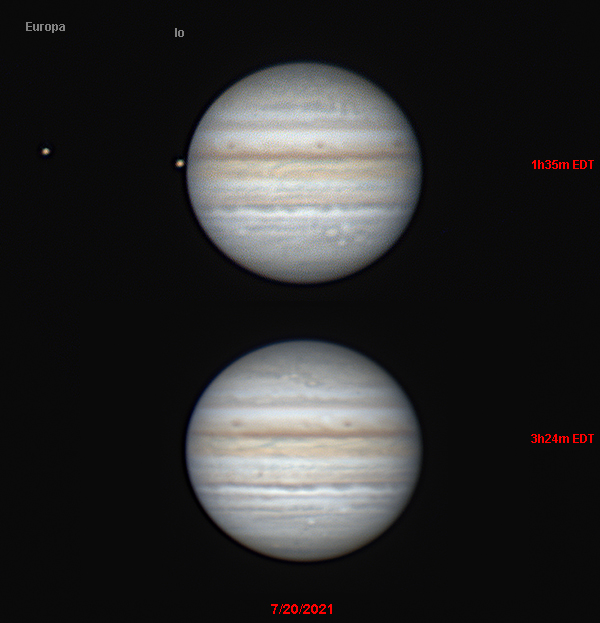
Telescope: Celestron C11 @ f/20, Orion Atlas EQ-G
Camera: ZWO ASI294MC Pro, 0C, GSO 2” 2x ED Barlow
Filter: Highpoint Scientific IR cut filter
Seeing: fair, 3/5, Smoke, haze
Exposure 1h35m: 3min x 75ms, gain 400, saved as SER
Exposure 3h24m EDT: 5x(3min x 50ms), gain 400, saved as SER
White Balance: Nebulosity Automatic
Software: SharpCap Pro, AutoStakkert, Registax, WinJUPOS, Nebulosity, Photoshop
These two image sets were taken about 2 hours apart on the morning of July 20th. The first image was a single 3 minute capture taken while Jupiter was fairly low in the east as insurance in case the sky conditions worsened. As I was setting up to start the sequence I had to wait a few minutes as Io was emerging from behind the planet and I wanted to be sure it was clear of Jupiter’s western limb. It was really neat to watch how fast Io moves! The second image was taken as Jupiter was nearing the meridian and was about as high as it was going to get above the horizon, about 37 degrees. This was a set of five 3 minute images sets de-rotated and combined in WinJUPOS. This technique reduces noise in a manner similar to dithering a deepsky image and it is informative to compare to compare this image with the single stack taken at 1h35m. This also illustrates how fast Jupiter rotates. For example, the ovals seen at the lower right in the first image have rotated completely out of view over the eastern limb in the second view. Also, Europa and Io have moved out of the field of view to the left. Neat stuff!
Recent Comments